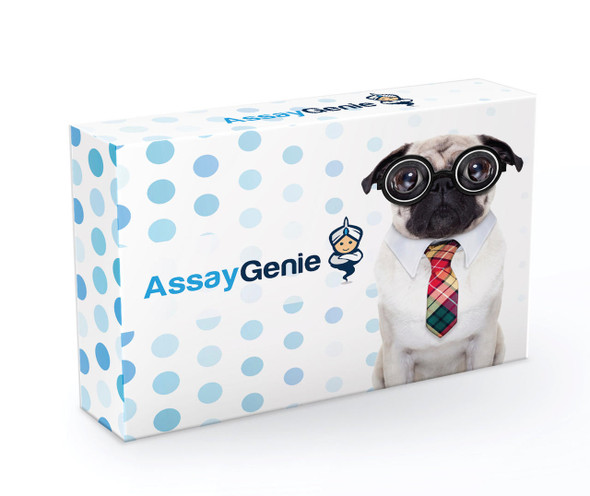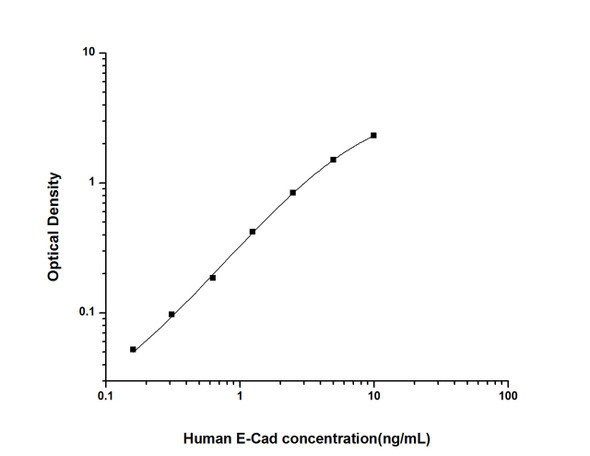Mouse Cell Biology ELISA Kits 2
Mouse E-Cad (E-Cadherin) CLIA Kit (MOES00133)
- SKU:
- MOES00133
- Product Type:
- ELISA Kit
- ELISA Type:
- CLIA Kit
- Size:
- 96 Assays
- Sensitivity:
- 9.38pg/mL
- Range:
- 15.63-1000pg/mL
- ELISA Type:
- Sandwich
- Synonyms:
- CDH1, Arc-1, CD324, CDHE, LCAM, UVO, CAM 120/80, Epithelial Cadherin, Uvomorulin
- Reactivity:
- Mouse
- Sample Type:
- Serum, plasma and other biological fluids
- Research Area:
- Cell Biology
Description
| Assay type: | Sandwich |
| Format: | 96T |
| Assay time: | 4.5h |
| Reactivity: | Mouse |
| Detection method: | Chemiluminescence |
| Detection range: | 15.63-1000 pg/mL |
| Sensitivity: | 9.38 pg/mL |
| Sample volume: | 100µL |
| Sample type: | Serum, plasma and other biological fluids |
| Repeatability: | CV < 15% |
| Specificity: | This kit recognizes Mouse E-Cad in samples. No significant cross-reactivity or interference between Mouse E-Cad and analogues was observed. |
This kit uses Sandwich-CLIA as the method. The micro CLIA plate provided in this kit has been pre-coated with an antibody specific to Mouse E-Cad. Standards or samples are added to the appropriate micro CLIA plate wells and combined with the specific antibody. Then a biotinylated detection antibody specific for Mouse E-Cad and Avidin-Horseradish Peroxidase (HRP) conjugate are added to each micro plate well successively and incubated. Free components are washed away. The substrate solution is added to each well. Only those wells that contain Mouse E-Cad, biotinylated detection antibody and Avidin-HRP conjugate will appear fluorescence. The Relative light unit (RLU) value is measured spectrophotometrically by the Chemiluminescence immunoassay analyzer. The RLU value is positively associated with the concentration of Mouse E-Cad. The concentration of Mouse E-Cad in the samples can be calculated by comparing the RLU of the samples to the standard curve.
| UniProt Protein Function: | CDH1: a single-pass type I membrane protein, and calcium dependent cell adhesion proteins. It is a ligand for integrin alpha-E/beta-7, and it colocalizes with DLG7 at sites of cell-cell contact in intestinal epithelial cells. Anchored to actin microfilaments through association with alpha-, beta- and gamma-catenin. Sequential proteolysis induced by apoptosis or calcium influx, results in translocation from sites of cell-cell contact to the cytoplasm. Involved in mechanisms regulating cell-cell adhesions, mobility and proliferation of epithelial cells. Defects in CDH1 are involved in dysfunction of the cell-cell adhesion system, triggering cancer invasion (gastric, breast, ovary, endometrium and thyroid) and metastasis. Has a potent invasive suppressor role. |
| UniProt Protein Details: | Protein type:Cell adhesion; Motility/polarity/chemotaxis; Membrane protein, integral; Ubiquitin ligase Cellular Component: apical junction complex; Golgi apparatus; internal side of plasma membrane; cell surface; focal adhesion; basolateral plasma membrane; lateral loop; integral to membrane; catenin complex; trans-Golgi network; intercellular junction; actin cytoskeleton; cell-cell adherens junction; adherens junction; membrane; apical part of cell; perinuclear region of cytoplasm; axon; cytoplasm; plasma membrane; nerve terminal; cell junction; endosome; lateral plasma membrane Molecular Function:protein domain specific binding; protein binding; gamma-catenin binding; metal ion binding; beta-catenin binding; GTPase activating protein binding; calcium ion binding; ankyrin binding; cell adhesion molecule binding; glycoprotein binding; protein phosphatase binding Biological Process: in utero embryonic development; positive regulation of transcription, DNA-dependent; regulation of caspase activity; regulation of epithelial cell proliferation; trophectodermal cell differentiation; regulation of water loss via skin; cell-cell adhesion; sensory perception of sound; regulation of protein localization; synaptogenesis; protein metabolic process; calcium-dependent cell-cell adhesion; positive regulation of transcription factor import into nucleus; negative regulation of cell-cell adhesion; cell adhesion; homophilic cell adhesion; protein homooligomerization; negative regulation of epithelial cell proliferation |
| UniProt Code: | P09803 |
| NCBI GenInfo Identifier: | 115419 |
| NCBI Gene ID: | 12550 |
| NCBI Accession: | P09803. 1 |
| UniProt Secondary Accession: | P09803,Q61377, |
| UniProt Related Accession: | P09803 |
| Molecular Weight: | 884 |
| NCBI Full Name: | Cadherin-1 |
| NCBI Synonym Full Names: | cadherin 1 |
| NCBI Official Symbol: | Cdh1 |
| NCBI Official Synonym Symbols: | Um; UVO; Ecad; E-cad; L-CAM; AA960649 |
| NCBI Protein Information: | cadherin-1; ARC-1; E-cadherin; uvomorulin; epithelial cadherin |
| UniProt Protein Name: | Cadherin-1 |
| UniProt Synonym Protein Names: | ARC-1; Epithelial cadherin; E-cadherin; Uvomorulin; CD_antigen: CD324Cleaved into the following 3 chains:E-Cad/CTF1; E-Cad/CTF2; E-Cad/CTF3 |
| Protein Family: | Cadherin |
| UniProt Gene Name: | Cdh1 |
| UniProt Entry Name: | CADH1_MOUSE |
As the RLU values of the standard curve may vary according to the conditions of the actual assay performance (e. g. operator, pipetting technique, washing technique or temperature effects), the operator should establish a standard curve for each test. Typical standard curve and data is provided below for reference only.
| Concentration (pg/mL) | RLU | Average | Corrected |
| 1000 | 53659 53691 | 53675 | 53650 |
| 500 | 20594 24384 | 22489 | 22464 |
| 250 | 10849 9573 | 10211 | 10186 |
| 125 | 4484 5318 | 4901 | 4876 |
| 62.5 | 2490 2416 | 2453 | 2428 |
| 31.25 | 1327 1235 | 1281 | 1256 |
| 15.63 | 665 751 | 708 | 683 |
| 0 | 24 26 | 25 | -- |
Precision
Intra-assay Precision (Precision within an assay): 3 samples with low, mid range and high level Mouse E-Cad were tested 20 times on one plate, respectively.
Inter-assay Precision (Precision between assays): 3 samples with low, mid range and high level Mouse E-Cad were tested on 3 different plates, 20 replicates in each plate.
| Intra-assay Precision | Inter-assay Precision | |||||
| Sample | 1 | 2 | 3 | 1 | 2 | 3 |
| n | 20 | 20 | 20 | 20 | 20 | 20 |
| Mean (pg/mL) | 46.98 | 84.00 | 358.52 | 45.95 | 76.80 | 383.64 |
| Standard deviation | 4.76 | 7.71 | 28.50 | 4.02 | 7.20 | 35.91 |
| C V (%) | 10.13 | 9.18 | 7.95 | 8.75 | 9.38 | 9.36 |
Recovery
The recovery of Mouse E-Cad spiked at three different levels in samples throughout the range of the assay was evaluated in various matrices.
| Sample Type | Range (%) | Average Recovery (%) |
| Serum (n=5) | 98-113 | 105 |
| EDTA plasma (n=5) | 90-104 | 96 |
| Cell culture media (n=5) | 102-116 | 107 |
Linearity
Samples were spiked with high concentrations of Mouse E-Cad and diluted with Reference Standard & Sample Diluent to produce samples with values within the range of the assay.
| Serum (n=5) | EDTA plasma (n=5) | Cell culture media (n=5) | ||
| 1:2 | Range (%) | 102-114 | 102-118 | 98-115 |
| Average (%) | 108 | 110 | 106 | |
| 1:4 | Range (%) | 103-119 | 90-100 | 97-113 |
| Average (%) | 110 | 95 | 105 | |
| 1:8 | Range (%) | 93-109 | 91-105 | 101-118 |
| Average (%) | 101 | 97 | 109 | |
| 1:16 | Range (%) | 92-106 | 88-101 | 88-100 |
| Average (%) | 97 | 95 | 93 |
An unopened kit can be stored at 4°C for 1 month. If the kit is not used within 1 month, store the items separately according to the following conditions once the kit is received.
| Item | Specifications | Storage |
| Micro CLIA Plate(Dismountable) | 8 wells ×12 strips | -20°C, 6 months |
| Reference Standard | 2 vials | |
| Concentrated Biotinylated Detection Ab (100×) | 1 vial, 120 µL | |
| Concentrated HRP Conjugate (100×) | 1 vial, 120 µL | -20°C(shading light), 6 months |
| Reference Standard & Sample Diluent | 1 vial, 20 mL | 4°C, 6 months |
| Biotinylated Detection Ab Diluent | 1 vial, 14 mL | |
| HRP Conjugate Diluent | 1 vial, 14 mL | |
| Concentrated Wash Buffer (25×) | 1 vial, 30 mL | |
| Substrate Reagent A | 1 vial, 5 mL | 4°C (shading light) |
| Substrate Reagent B | 1 vial, 5 mL | 4°C (shading light) |
| Plate Sealer | 5 pieces | |
| Product Description | 1 copy | |
| Certificate of Analysis | 1 copy |
- Set standard, test sample and control (zero) wells on the pre-coated plate and record theirpositions. It is recommended to measure each standard and sample in duplicate. Note: addall solutions to the bottom of the plate wells while avoiding contact with the well walls. Ensuresolutions do not foam when adding to the wells.
- Aliquot 100µl of standard solutions into the standard wells.
- Add 100µl of Sample / Standard dilution buffer into the control (zero) well.
- Add 100µl of properly diluted sample (serum, plasma, tissue homogenates and otherbiological fluids. ) into test sample wells.
- Cover the plate with the sealer provided in the kit and incubate for 90 min at 37°C.
- Aspirate the liquid from each well, do not wash. Immediately add 100µL of BiotinylatedDetection Ab working solution to each well. Cover the plate with a plate seal and gently mix. Incubate for 1 hour at 37°C.
- Aspirate or decant the solution from the plate and add 350µL of wash buffer to each welland incubate for 1-2 minutes at room temperature. Aspirate the solution from each well andclap the plate on absorbent filter paper to dry. Repeat this process 3 times. Note: a microplatewasher can be used in this step and other wash steps.
- Add 100µL of HRP Conjugate working solution to each well. Cover with a plate seal andincubate for 30 min at 37°C.
- Aspirate or decant the solution from each well. Repeat the wash process for five times asconducted in step 7.
- Add 100µL of Substrate mixture solution to each well. Cover with a new plate seal andincubate for no more than 5 min at 37°C. Protect the plate from light.
- Determine the RLU value of each well immediately.






